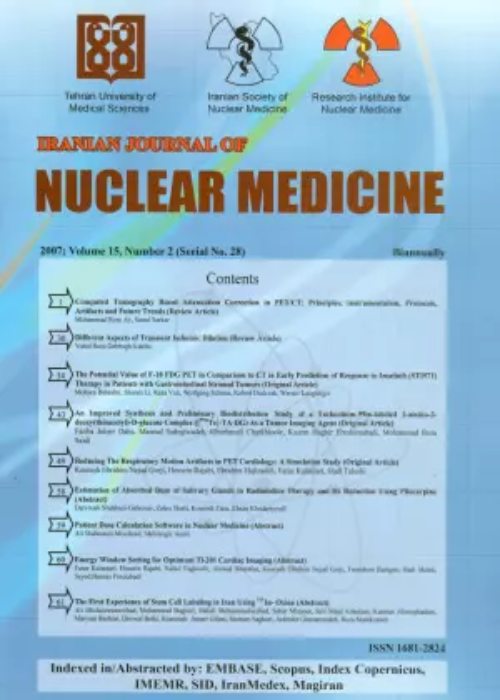Comparing PET metabolic parameters with clinicopathological factors in predicting onset of early recurrence in recently diagnosed hepatocellular carcinoma
Author(s):
Article Type:
Research/Original Article (دارای رتبه معتبر)
Abstract:
Introduction
Early recurrence of hepatocellular carcinoma (HCC) is a major risk factor affecting survival even after hepatectomy. Many clinical, biochemical parameters and pathological grading like fibrosis 1 index have been used for risk stratifying HCC. However not many studies have combined all of them. It is therefore important to risk stratify HCC especially with newer PET based metabolic parameters to see if they match with existing clinicopathological parameters to achieve better clinical outcome. The objectives of this study were twofold; firstly, to evaluate [18F]FDG PET as a prognostic biomarker to predict tumour recurrence. Secondly, if clinicopathological parameters combined with PET indices increase the risk correlate in predicting HCC disease recurrence. Methods
Records of 200 adult HCC patients were analysed, (6:1, Male: Female; mean age ± SD, 52 ± 2 year). All underwent [18F]FDG PET (PET MR: PET CT = 168:32) and subsequent therapy. Patients had a follow up for at least 15 months or onset of first recurrence, whichever was earlier. Clinicopathological data, alpha-fetoprotein (AFP) titres, SUVmax and few other PET indices were documented along with details of first recurrence. Statistical analysis was also performed. Results
In a multivariate analysis of various prognostic factors including T (SUVmax)/ L (SUVmax), serum alpha-fetoprotein, T stage, size of tumour, and vascular invasion of tumour, T (SUVmax)/ L (SUVmax) was the most significant with a cut off value of 1.9. Only vascular invasion of tumour and AFP titres had additional significance. 16% ( 32/200 patients) developed recurrence (OR 1.673). Comparing the low and high AFP titres by Kaplan Meir curve, P was found to be 0.039 that predicted a worse prognosis in patients with higher AFP titres. Similarly patients with higher SUV T/L: ratio of tumour SUVmax to liver (> 1.9) also revealed higher recurrence rate. Cut-off SUVmax was 3.03 g/ml in our series (range 2.5 - 23.8 g/ml) and found to be strongly associated with AFP, tumour size, number, and histological grade of tumour. Conclusion
Our study shows that PET based metabolic indices are effective robust tools to predict tumour recurrence in aggressive HCC. Secondly, when clinicopathological parameters are combined with PET based indices there is better prediction of HCC recurrence and one can reclassify HCC patients into mild, moderate, and high-risk groups. We found it very useful in predicting poor clinical outcome especially in high-risk HCC patients; so that stricter surveillance measures can be recommended to identify early recurrence and offer appropriate therapy. The strength of this study lies in the fact that the observed associations between the combined parameters were found to be stronger than those reported in the past.Keywords:
Language:
English
Published:
Iranian Journal of Nuclear Medicine, Volume:30 Issue: 1, Winter-Spring 2022
Pages:
1 to 9
magiran.com/p2379015
دانلود و مطالعه متن این مقاله با یکی از روشهای زیر امکان پذیر است:
اشتراک شخصی
با عضویت و پرداخت آنلاین حق اشتراک یکساله به مبلغ 1,390,000ريال میتوانید 70 عنوان مطلب دانلود کنید!
اشتراک سازمانی
به کتابخانه دانشگاه یا محل کار خود پیشنهاد کنید تا اشتراک سازمانی این پایگاه را برای دسترسی نامحدود همه کاربران به متن مطالب تهیه نمایند!
توجه!
- حق عضویت دریافتی صرف حمایت از نشریات عضو و نگهداری، تکمیل و توسعه مگیران میشود.
- پرداخت حق اشتراک و دانلود مقالات اجازه بازنشر آن در سایر رسانههای چاپی و دیجیتال را به کاربر نمیدهد.
In order to view content subscription is required
Personal subscription
Subscribe magiran.com for 70 € euros via PayPal and download 70 articles during a year.
Organization subscription
Please contact us to subscribe your university or library for unlimited access!


